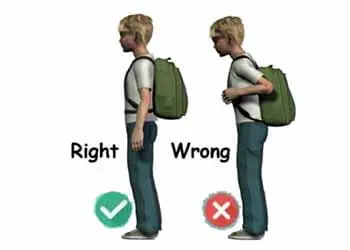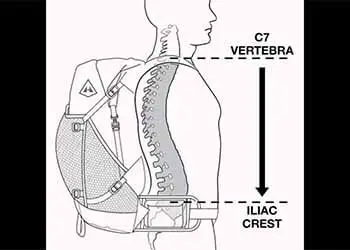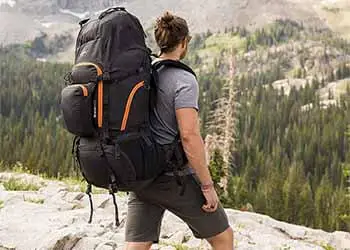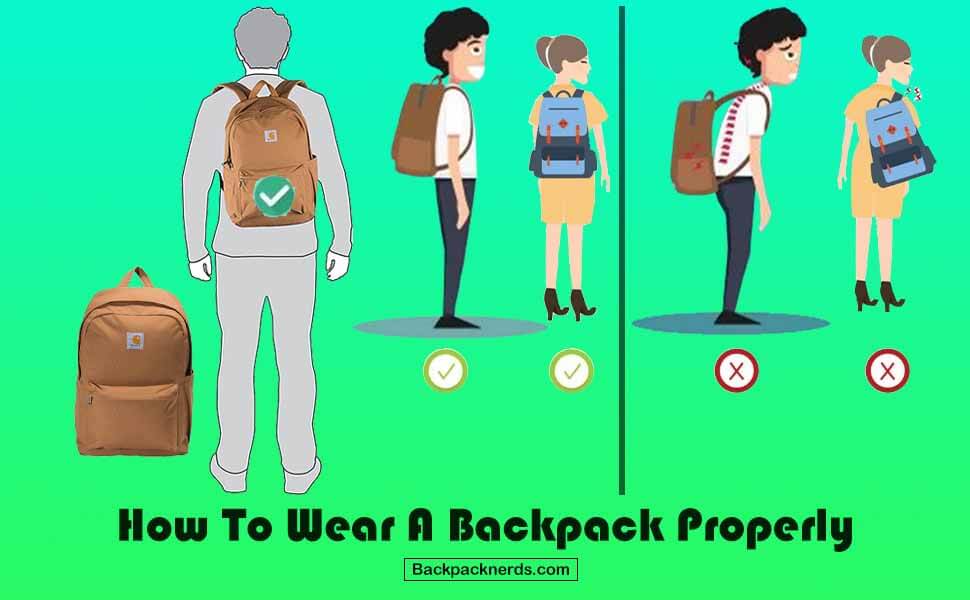Backpacks are a popular and practical way to carry your belongings, but wearing them improperly can cause discomfort and even injury. Whether you’re hiking in the mountains or commuting to work, learning how to wear a backpack properly is essential for your comfort and safety. In this guide, we’ll explore some simple steps you can take to ensure that your backpack fits correctly and distributes weight evenly, so you can enjoy your activities without any discomfort or pain.
Dangers of Carrying a Heavy Backpack Incorrectly?
Carrying a heavy backpack every day can pose several dangers, especially if the backpack is not worn correctly. Here are some of the potential dangers:
- Back and neck pain: Carrying a heavy backpack can put extra strain on your back and neck muscles, leading to pain and discomfort.
- Poor posture: Wearing a backpack incorrectly, such as slinging it over one shoulder, can cause you to develop poor posture, which can lead to long-term health problems.
- Shoulder pain: A heavy backpack can also cause shoulder pain, particularly if it is not worn correctly and evenly distributed across both shoulders.
- Reduced mobility: Carrying a heavy backpack can make it more difficult to move around, particularly if you need to climb stairs or walk for long periods.
- Nerve damage: If a heavy backpack is worn incorrectly and presses on nerves, it can cause tingling, numbness, or weakness in your arms or hands.
- Higher Risk of Arthritis: When a backpack is worn in the wrong way, it moves the center of gravity and compresses your body’s internal organs. This can cause your body’s hips, knees, and elbows to develop arthritis.
To reduce the risk of these dangers, it’s important to choose a backpack that fits well and evenly distributes the weight across both shoulders. It’s also important to avoid carrying too much weight in the backpack and to adjust the straps properly to ensure a good fit.
Tips: If you experience pain or discomfort while carrying a backpack, it’s important to take breaks and stretch regularly.
Incorrect Ways of Wearing a Backpack

If you frequently carry a heavy backpack, you may be at risk of developing pain and discomfort in your back, neck, and shoulders. One of the main causes of this discomfort is wearing your backpack incorrectly.
So, knowing how to wear a backpack without hurting your back is necessary because we need to carry our backpacks every day.
In this talk, we’ll discuss the incorrect ways of wearing a backpack and provide strategies to prevent these issues.
Here are some common incorrect ways of wearing a backpack:
- Wearing it over one shoulder: Carrying a backpack over one shoulder can cause uneven weight distribution, leading to strain on one side of your body.
- Wearing A Backpack On Your Front: If you wear your backpack on your front, you may find yourself hunching forward or leaning backward, both of which can cause strain on your lower back. Wearing backpack in front can be particularly problematic for individuals who already experience lower back pain due to prolonged periods of sitting in a chair.
- Wearing it too low: If you wear your backpack too low on your back, it can pull you backward, causing you to lean forward to compensate. This can cause back and neck pain.
- Wearing it too high: Wearing a backpack too high on your back can cause discomfort in your shoulders and neck.
- Not adjusting the straps: If the straps on your backpack are not adjusted properly, the weight may not be evenly distributed, causing discomfort and strain on your body.
- Overpacking: Carrying too much weight in your backpack can put a strain on your back and shoulders.
To avoid these incorrect ways of wearing a backpack, it’s important to choose a backpack that fits well and has adjustable straps. When wearing your backpack, make sure it sits comfortably on your back, with the weight evenly distributed across both shoulders. Adjust the straps so that the backpack sits snugly against your back, without pulling you backward or forward. Finally, be mindful of the weight you carry in your backpack and try to pack only what you need.
How to Ensure Your Backpack Actually Fits You Properly
A properly fitting backpack can make all the difference when it comes to comfort and reducing the risk of injury. That’s why backpack users should know how to properly wear a backpacking backpack. Here are some tips to ensure your backpack fits you properly:

- Know your torso length: Measure your torso length from the base of your neck to the top of your hips. This will help you choose a backpack with the right length. We will know in later paragraphs about how to measure your torso length.
- Look for adjustable straps: The shoulder straps, hip belt, and sternum strap should all be adjustable to fit your body.
- Adjust the shoulder straps: Start by loosening all the straps and then put the backpack on. Adjust the shoulder straps so that they sit comfortably on your shoulders and distribute the weight of the backpack evenly.
- Adjust the hip belt: The hip belt should sit snugly on your hips and take most of the weight of the backpack. Adjust it so that it sits comfortably and doesn’t slip down. If you are an expert, you know where should a backpack sit on your hips.
- Adjust the sternum strap: The sternum strap helps to stabilize the backpack and reduce shoulder strain. Adjust it so that it sits comfortably across your chest.
- Check the load-lifters: Load-lifter straps connect the top of the shoulder straps to the top of the backpack and help to distribute the weight evenly. Adjust them so that they angle slightly towards your body.
- Test the fit: Once you have adjusted all the straps, walk around with the backpack on to ensure that it feels comfortable and the weight is evenly distributed.
Remember, a properly fitting backpack should feel comfortable and stable on your back, with the weight distributed evenly across your hips and shoulders. If you’re unsure about how to fit your backpack properly, don’t hesitate to ask a professional at a sporting goods store or outdoor retailer for assistance. So, what is the right way to wear a backpack?
How to Wear a Backpack Properly

Wearing a backpack properly is important for preventing back pain and injury. So, by knowing how to properly wear a backpack, you can avoid these risks. Here are some tips to help you wear a backpack without hurting your back:
Choose the right backpack
Look for a backpack that fits your body properly and is designed for your intended purpose. Backpacks with padded straps and a waist belt are ideal for distributing the weight of the backpack evenly.
Adjust the straps
Make sure the straps are adjusted so that the backpack sits comfortably on your back. The backpack should be snug against your body without pulling or causing discomfort.
Use the waist belt
The waist belt helps to distribute the weight of the backpack evenly and takes the pressure off of your shoulders and back.
Distribute weight evenly
When packing your backpack, distribute the weight evenly throughout the backpack. Place heavier items closer to your back to minimize strain on your back and shoulders.
Use hip and chest straps
If your backpack has hip and chest straps, use them to help distribute the weight of the backpack evenly across your body.
Use both straps
Always use both straps when wearing a backpack. Using only one strap can cause an imbalance and lead to back pain.
Don’t overload your backpack
Be mindful of how much weight you’re carrying in your backpack. Overloading your backpack can cause strain on your back and shoulders.
Take breaks
If you’re carrying a heavy backpack for an extended period of time, take breaks to give your back and shoulders a rest.
Properly wearing a backpack is not only important for comfort, but also for preventing potential injuries. By following the steps outlined above, you can ensure that your backpack fits correctly and that the weight is distributed evenly. So next time you need to carry a backpack, take a moment to make sure you’re wearing it properly to avoid any unnecessary discomfort or injury.
Related Articles:
How to Measure Your Torso Length to Choose a Good Backpack?

To measure your torso length to choose a backpack, follow these steps:
- Stand up straight with your head facing forward and your chin level.
- Tilt your head slightly forward to feel the bony bump at the base of your neck. This is your C7 vertebra, and it marks the top of your torso.
- Place your hands on your hips with your thumbs along your back, and your fingers wrapping around your sides. The point where your thumbs meet your spine is the top of your hip bones.
- Use a flexible measuring tape to measure the distance between the C7 vertebra at the base of your neck and the top of your hip bones. This measurement is your torso length.
- Record your torso length and use it to choose a backpack that matches your size. Many backpack manufacturers provide size guides that indicate which backpack size is appropriate for a given torso length.
By choosing a backpack that matches your torso length, you can ensure that the pack will sit comfortably on your back and distribute weight evenly, reducing the risk of injury or discomfort.
What Are The Two Commonly Incorrect Ways To Wear A Backpack?
Among many styles of incorrect ways of wearing a backpack, there are two very common ways that adults as well as kids wear a backpack are as follows:
- The One Strap Sling Method of Wearing: One strap sling method of wearing is a very improper backpack fit for everyone. This method involves slinging the backpack over one shoulder and carrying it on your back, with the backpack hanging diagonally across your torso. This method is often used by people who want to look stylish or cool, but it can be harmful to your body. Carrying a heavy backpack on one shoulder can cause strain on your neck, shoulder, and back muscles, leading to pain and discomfort. This can also cause an imbalance in your body, leading to poor posture.
- Low Back Pack Method of Wearing: This method involves wearing the backpack too low on the back, often resting on the hips or lower back. This method can cause strain on your lower back muscles and can also pull you backward, making it difficult to maintain good posture. This can cause discomfort and pain in your back and shoulders, and can also increase your risk of injury, especially if you are carrying heavy items in your backpack. Additionally, wearing a backpack too low can make it difficult to see where you are going and can hinder your movement.
If you can avoid these methods while wearing a pack on your back, you can get rid of the backpack along with other risky dangers. So, you should try to put your backpack on properly and know how to carry them correctly.
5 Tips on How to Prevent Your Back and Neck Pain by Wearing A Backpack Right Way
Many people rely on backpacks to carry their belongings, whether it’s for school, work, or travel. However, carrying a backpack improperly can lead to back pain and other health issues. Fortunately, there are steps you can take to wear your backpack the right way and prevent discomfort and injury. Now we’ll explore some tips on how to prevent back pain by properly wearing a backpack.
- Choose the right backpack: When choosing a backpack, make sure it’s the right size for your body and your needs. A backpack that is too large or too small can put unnecessary strain on your back.
- Distribute weight evenly: Distribute the weight of your backpack evenly across your shoulders and back. Adjust the straps so the backpack fits snugly against your back without hanging too low.
- Use both shoulder straps: Don’t carry your backpack over one shoulder. Use both shoulder straps to distribute the weight evenly and avoid straining one side of your body.
- Use waist and chest straps: Some backpacks come with waist and chest straps. Use them to help distribute the weight of the backpack more evenly and take some of the strain off your back.
- Pack smartly: Pack heavier items closer to your back and lighter items further away to help balance the weight. Use compartments and pockets to organize your belongings and make them easier to access.
By following these tips, you can wear your backpack properly, reduce the strain on your back, and prevent discomfort and injury. Remember to be mindful of how you wear your backpack to avoid causing unnecessary strain on your body.
How Children Should Wear A Backpack?

Wearing a backpack is a common daily activity for children, whether they are going to school, on a field trip, or on a hike. It’s important to ensure that children are wearing their backpacks properly to avoid potential injury or strain.
The American Academy of Pediatrics recommends that children should carry no more than 10% to 20% of their body weight in their backpacks. That means that it should probably weigh 4 to 15 pounds at most.
Here are some tips on how children should wear a backpack:
- Choose the Right Backpack: Choose a backpack that is the right size for your child, not too large or too small. The backpack should fit comfortably on your child’s back and not be too heavy when loaded.
- Use Both Straps: Make sure your child is wearing both shoulder straps and that they are adjusted to fit snugly but not too tightly. The backpack should be centered on your child’s back and not drooping down to one side.
- Adjust the Height: Adjust the height of the backpack so that the bottom of the backpack is at the level of your child’s waist. This will distribute the weight of the backpack evenly across your child’s body.
- Pack Lightly: Encourage your child to only pack what is necessary for the day, and to distribute the weight of the backpack evenly. Heavier items should be placed closer to the child’s back, with lighter items towards the front.
- Wear Properly: Remind your child to wear the backpack properly, with both shoulder straps on and the backpack centered on their back. They should avoid carrying the backpack over one shoulder, as this can lead to strain and injury.
Some additional precautions your child can take when wearing a backpack are:
- Avoid carrying the backpack for extended periods of time.
- Remove the backpack when sitting down or waiting for long periods of time.
- Bend at the knees and use both hands to lift the backpack onto their back.
- If the backpack feels too heavy, encourage your child to ask for help or to use a rolling backpack instead.
By following these precautions, your child can wear their backpack safely and comfortably, and avoid potential injury or strain.
How to Wear Different Types of Backpacks
How to Wear a Hiking Backpack?

How to wear a heavy backpack? Wearing a hiking backpack properly is important for your comfort and safety on the trail. To start, adjust the shoulder straps so that they are snug but not too tight. The backpack should rest comfortably on your shoulders and not slip down. Next, adjust the hip belt so that it sits comfortably around your hips, not your waist. This will transfer the weight of the backpack from your shoulders to your hips, reducing strain on your back. Make sure the backpack is centered on your back and not tilting to one side. Finally, adjust any additional straps, such as the chest strap or load lifters, to ensure a secure and comfortable fit. It may take some trial and error to find the perfect fit, so make adjustments as needed throughout your hike. Properly wearing your hiking backpack can make a big difference in your comfort and enjoyment on the trail.
How to Wear a Crossbody Backpack?
Wearing a crossbody backpack can be a stylish and practical way to carry your essentials, whether you’re commuting to work or exploring a new city. To start, adjust the straps so that the backpack sits comfortably on your back and rests on your hip. The strap should be snug enough to keep the backpack in place but not too tight that it restricts your movement. Make sure the backpack is centered on your back and not tilting to one side. The length of the strap should be adjusted so that the backpack sits at the height you prefer, whether it’s at your waist or slightly lower. Additionally, if your crossbody backpack has multiple compartments, make sure to distribute the weight evenly so that it doesn’t pull to one side. Overall, a properly worn crossbody backpack should feel comfortable and secure, and allow you to move freely while carrying your essentials.
How to Wear Your School Backpack Correctly?
Wearing a school backpack correctly can help prevent discomfort, strain, and injury. First, adjust the shoulder straps so that the backpack sits comfortably on your back and not too low. The backpack should rest on your shoulders and not slip down. The straps should be snug but not too tight. Next, adjust the waist or hip belt so that it sits comfortably around your hips, not your waist. This will transfer the weight of the backpack from your shoulders to your hips, reducing strain on your back. Make sure the backpack is centered on your back and not tilting to one side. Finally, distribute the weight of the contents evenly throughout the backpack. Avoid carrying too many heavy items that can strain your back and shoulders. By wearing your school backpack correctly, you can reduce the risk of discomfort or injury, allowing you to carry your essentials comfortably and safely throughout the school day.
How to Wear a Drawstring Backpack?
To wear a drawstring backpack, simply put the straps over your shoulders like a backpack and adjust the length of the straps to your desired fit. Then, pull the drawstrings tight to close the top of the bag and secure your belongings. It’s important to distribute the weight of your belongings evenly throughout the bag to avoid strain on your back. With its lightweight and easy-to-use design, a drawstring backpack is a convenient option for carrying essentials on the go.
Read More Articles:
- How to Wear a Sling Bag?
- Backpack Checked Luggage
- How Big is a 20 Liter Backpack?
- How Big is a 40 Liter Backpack
- How to Measure Luggage
- How Big Is a 30 Liter Backpack
- North Face Recon vs Borealis
- How Many Books Can You Put In an Empty Backpack
- How to Remove Embroidery from a Backpack
- Can You Wash Pottery Barn Backpacks
What to Consider When Buying a Good Backpack?

A backpack is an essential item for many people, whether it’s for school, work, travel, or outdoor activities. However, with so many options available, it can be difficult to know what to look for when buying a good backpack. In this article, we’ll explore some important factors to consider when choosing a backpack to help you find the perfect one for your needs.
When buying a good backpack, here are some factors to consider:
- Purpose: Consider what you’ll be using the backpack for. Will you be using it for school, work, hiking, or travel? Different purposes may require different features.
- Size and capacity: Look for a backpack that is the right size for your needs. Consider how much you’ll be carrying and make sure the backpack has enough capacity to accommodate your belongings.
- Comfort: A comfortable backpack is important, especially if you’ll be wearing it for extended periods of time. Look for backpacks with padded shoulder straps, a padded back panel, and a chest strap to distribute the weight evenly.
- Durability: A good backpack should be durable enough to withstand everyday wear and tear. Look for backpacks made of high-quality materials and check the stitching and zippers to make sure they’re sturdy.
- Organization: Look for backpacks with multiple compartments and pockets to help you stay organized. This can be especially important if you’ll be using the backpack for school or work.
- Style: Backpacks come in a variety of styles and designs. Consider your personal style and preferences when choosing a backpack.
- Price: Good backpacks can range in price from budget-friendly to high-end. Consider your budget and look for a backpack that provides the features and quality you need at a price point you can afford.
In summary, when buying a good backpack, it’s important to consider factors such as purpose, size and capacity, comfort, durability, organization, style, and price. By taking these factors into account, you can find a backpack that meets your needs, is comfortable to wear, and is durable enough to last for years to come.
Some Quality Backpacks You May Want to Buy –
Final Words
In conclusion, wearing a backpack properly is essential for maintaining good posture and avoiding potential back and shoulder injuries. It is important to choose a backpack that fits well and is not too heavy. Always use both shoulder straps and adjust them to ensure the weight is distributed evenly across your back. Additionally, avoid carrying the backpack too low on your back or allowing it to swing as you walk. You can wear your backpack safely and comfortably for extended periods by following the guidelines.
Image Credit:

